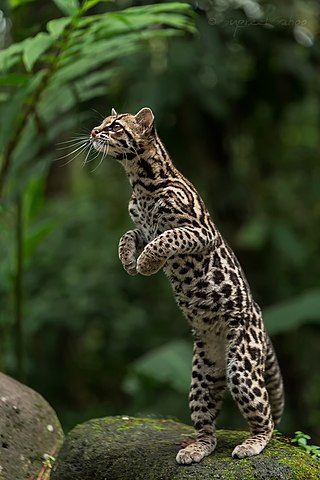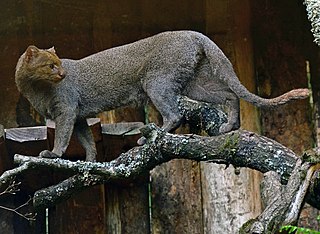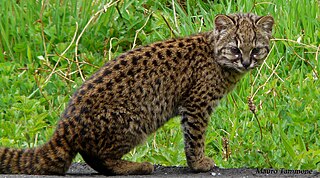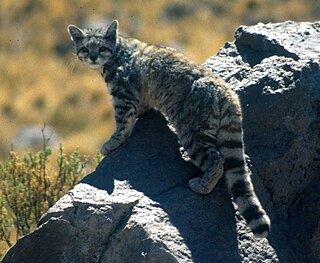
Felidae is the family of mammals in the order Carnivora colloquially referred to as cats. A member of this family is also called a felid. The term "cat" refers both to felids in general and specifically to the domestic cat.
Panthera is a genus within the family Felidae, it is one of two extant genera in the subfamily Pantherinae, and contains the largest living members of the cat family. There are 5 living species, the tiger, jaguar, lion, leopard and snow leopard and a number of extinct species.

The margay is a small wild cat native to Central and South America. A solitary and nocturnal felid, it lives mainly in primary evergreen and deciduous forest.

The ocelot is a medium-sized spotted wild cat that reaches 40–50 cm (15.7–19.7 in) at the shoulders and weighs between 7 and 15.5 kg on average. It is native to the southwestern United States, Mexico, Central and South America, and the Caribbean islands of Trinidad and Margarita. Carl Linnaeus scientifically described it in 1758. Two subspecies are recognized.

The oncilla, also known as the northern tiger cat, little spotted cat, and tigrillo, is a small spotted cat ranging from Central America to central Brazil. It is listed as Vulnerable on the IUCN Red List, and the population is threatened by deforestation and conversion of habitat to agricultural land.

The jaguarundi is a wild cat native to the Americas. Its range extends from central Argentina in the south to northern Mexico, through Central and South America east of the Andes. The jaguarundi is a medium-sized cat of slender build. Its coloration is uniform with two color morphs, gray and red. It has an elongated body, with relatively short legs, a small, narrow head, small, round ears, a short snout, and a long tail, resembling mustelids in these respects. It is about twice as large as a domestic cat, reaching nearly 360 mm (14 in) at the shoulder, and weighs 3.5–7 kg (7.7–15.4 lb).

The kodkod, also called güiña, is the smallest felid species native to the Americas. It lives primarily in central and southern Chile, as well as marginally in adjoining areas of Argentina. Since 2002, it has been listed as Vulnerable on the IUCN Red List as the total population may be less than 10,000 mature individuals; it is threatened by persecution, and loss of habitat and prey base.

The Andean mountain cat is a small wild cat native to the high Andes that has been listed as Endangered on the IUCN Red List because fewer than 1,500 individuals are thought to exist in the wild. It is traditionally considered a sacred animal by indigenous Aymara and Quechua people.

Geoffroy's cat is a small wild cat native to the southern and central regions of South America. It is about the size of a domestic cat. It is listed as Least Concern on the IUCN Red List because it is widespread and abundant over most of its range.

Leopardus is a genus comprising eight species of small cats native to the Americas. This genus is considered the oldest branch of a genetic lineage of small cats in the Americas whose common ancestor crossed the Bering land bridge from Asia to North America in the late Miocene.

The Pantherinae is a subfamily of the Felidae; it was named and first described by Reginald Innes Pocock in 1917 as only including the Panthera species. The Pantherinae genetically diverged from a common ancestor between 9.32 to 4.47 million years ago and 10.67 to 3.76 million years ago.

The Pampas cat is a small wild cat native to South America. It is listed as Near Threatened on the IUCN Red List as habitat conversion and destruction may cause the population to decline in the future.

Humboldt's hog-nosed skunk, also known as the Patagonian hog-nosed skunk, is a species of hog-nosed skunk indigenous to the open grassy areas in the Patagonian regions of South Argentina and Chile. It belongs to the order Carnivora and the family Mephitidae.

Leopardus guttulus, the southern tigrina or southern tiger cat, is a small wild cat species native to Brazil, Argentina and Paraguay.

The Sunda leopard cat is a small wild cat species native to the Sundaland islands of Java, Bali, Borneo, Sumatra and the Philippines that is considered distinct from the leopard cat occurring in mainland South and Southeast Asia.

Garlepp's pampas cat, also called the northern pampas cat, is a subspecies of the pampas cat. It has more recently been classified as a full species within a pampas cat species complex. Garlepp's pampas cat is native to the central-western mountainous area of South America.














